This post may contain affiliate links which won’t change your price but will share some commission.
Hey hey! Hope everyone had a nice Valentine’s Day whether you spent it with your love or yourself or your cat, whom you refer to as your love. 🙂
I’ve actually skipped away for a few days with my BFF to warm and sunny … Chicago.
Yeah, not sure how that happened, Chicago in February that is, but we’re hoping to spend some time walking around with our cameras since she just got a new one so you may end up seeing more of our trip than you hope to. 🙂
But, I have a HUGE tip for you today. One that I feel like I should have known. Or at least I should have deduced. (Just because I wanted to use that word in a sentence.) Because it actually makes total sense, I just didn’t realize it. And it’s about how to caulk exterior siding and why not to caulk newly installed pressure treated wood.
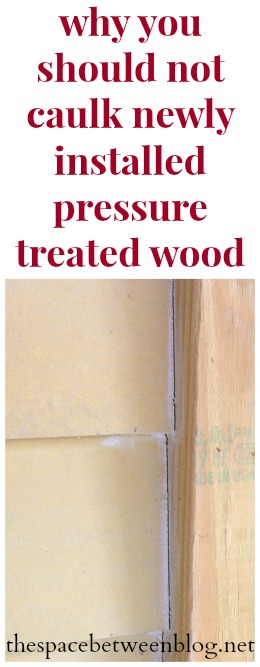
So, pressure treated wood is lumber than has been chemically treated to resist against rot, fungus, insects and other random grossness that happens when things live outside. When we built-out our exterior wall over the old faux brick that was all done in pressure treated plywood. And then when my dad and I tackled the exterior trim we used all pressure treated lumber as well.
After we had all of the trim installed and had a solid start of the hardiboard siding installation I got busy with some caulk. (Please resist the urge to giggle.)
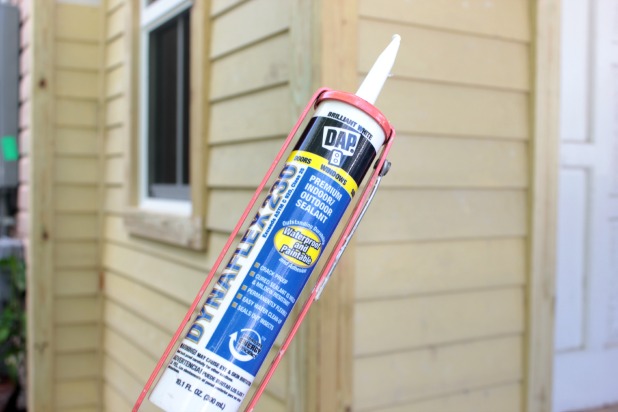
Any guesses how many tubes I’ve used so far? 12 tubes so far. And I’ve declared 3 tubes at a time to be my limit. And I haven’t even started on the soffit or any of the areas above the porch roof. But I will. Soon.
But I need to thank my 3 tube limit for giving me the time I needed to learn this tip.
Here’s what happened, I jumped right into the caulking after the trim install and, for the sake of using arbitrary percentages, completed maybe 20% of it. But for some reason, to avoid getting into the monotony of caulking under every single row of siding, I did all of the windows and the door first.
And then, declaring this job the worst ever, and taking a few weeks away from the madness I discovered this.

Cracks! In my caulk! My caulk had cracked! I was far too perturbed to even consider giggling at the idea of it.
But then I noticed something else.
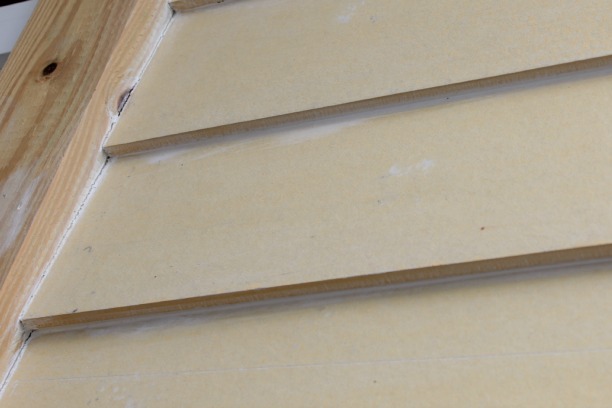
The caulk was still perfect in the few areas I had caulked along the siding.
The thing is, over time the chemical treatment in the pressure treated wood dries out and the wood contracts and literally gets a tiny bit smaller since it’s not now swollen with moisture.
That left my gaps bigger and the need for a larger more caulk.
Just to try to induce some extra sympathy let’s look at all of the pressure treated wood we’re working with.
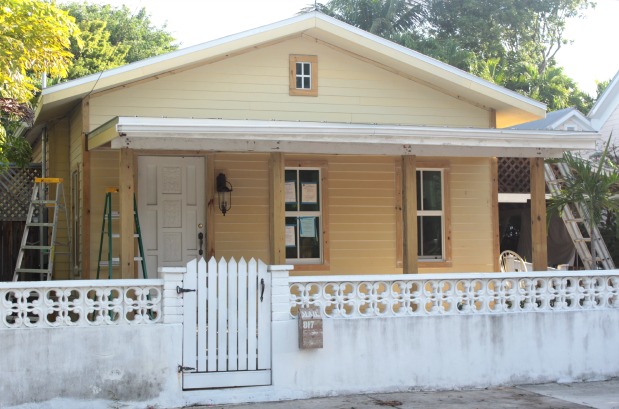
That’s every window (there are 5), the door, every corner transition (there are 6, and 2 pressure treated boards on each outer corner, of which there are 4), the top of every wall where there is a trim board right below the roof (there are 2 roofs or is it rooves, like hooves?).
But, I was thankful to have learned something new, and to have a built-in excuse for procrastinating getting started on the caulk above the porch roof. Since it was just a crack in the caulk and not a new crack in a hard surface material I didn’t have to do anything crazy like cut out all of the caulk. Thankfully I could just run a new bead of caulk and chalk it up to a lesson learned.
And a few more caulking tips while we’re on the topic:
- don’t cut too much of the tip of the tube of caulk off, it is easier to control with a smaller opening, but not too small, large enough to have enough caulk come out to work with, I would say a 3 mm opening, google it, that’s what I did (random fact, a standard pencil eraser is 5 mm, you’re welcome)
- don’t be afraid to make a mess, caulk is pretty easy clean up and as long as you work in small sections and stay ahead of its drying time you can always clean up after yourself
- keep a wet rag or sponge with you, you know, to clean up after yourself
- I’ve seen a bunch of different tools but my finger is still my preferred “smooth out” method, especially around uneven surfaces like siding
- this will happen
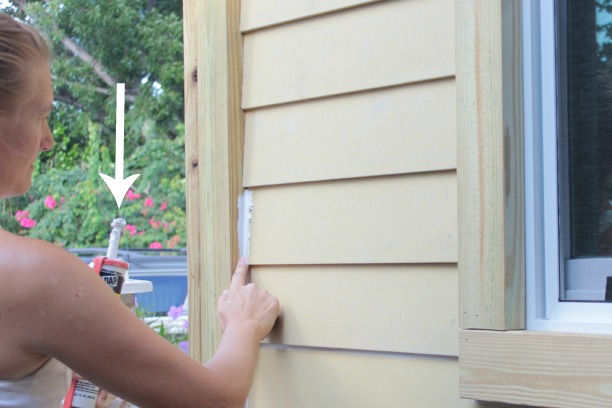 You’ll be going along, creating a nice seal with your caulk …
You’ll be going along, creating a nice seal with your caulk …
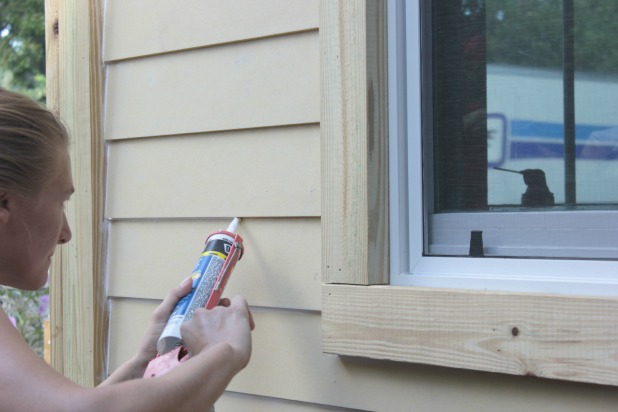
And then you’ll need to pause for a second to wipe or smooth or clean up an area and because of the pressure built up in the tube it will just keep on coming out, even though you don’t want it to.
I just slop it up there and smooth it out as best I can with my finger.
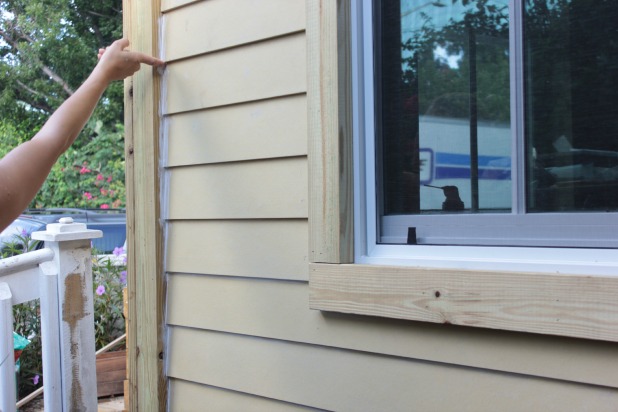
And then smooth it out with the rag.
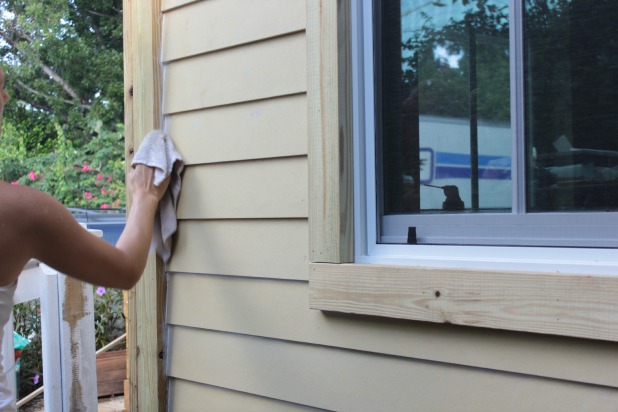
And you’ve got yourself a nice cleanly caulked seal. After you’ve let the pressure treated wood dry out for at least a week of course.
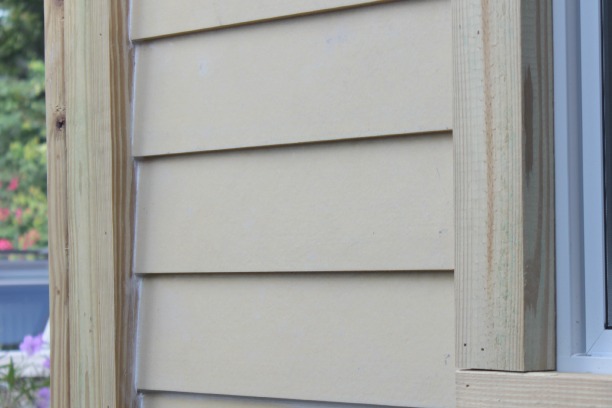
Update: Some readers have sent other great tips, if you have any you want me to add please feel free to leave them in the comments. Like:
- when you are finished laying a bead of caulk, relieve the pressure on the gun by releasing the plunger
- when you’re finished, close the tube with any unused caulk using large electrical wire nuts <- we wrap the end in painter’s tape, but I really love this idea, too
The reality is these tubes of caulk, even the good ones are only a few dollars so you could just wipe off the tip of the tube and sacrifice those globs of caulk, but I can’t get myself to through out even pennies worth of it when I know it can be used. What’s that they say, a penny saved …
As of today, to toss out another arbitrary percentage, I would say I’m about 70% complete with the caulking project (just on the front of the house where the new siding and trim is), and I have to admit, I won’t be sad to see it end. But after I itemized all of the next steps with the exterior work here to get ready for a whole new paint job, I’m not exactly jumping up and down in excitement over my work ahead. Thank goodness for good music and happy hours.

lcarver0 says
Nice article Karah. I am not a super expert on sealants and caulking, but I have dabbled here and there. (We live in the S.F. bay area of California.) After using part of a tube, I like to rotate a screw into the open tip … either a wood screw, drywall screw, or any self-tapping type of screw (not a machine screw); at a later date, just pull it back out, or else rotate it back out.
Where you show some of the siding joints remaining intact, and the other ones completely open up, I had two thoughts.
First, what about the fact that these pieces/members are going to expand and contract (with moisture, and with age) primarily along their long axis. You’d expect to see a little bit of dimension instability along the short direction, but there’ll be more movement along the length direction.
Second, for some of these situations have you gone for an elastomeric caulk, i.e. one that’s supposed to comply more with things moving? I remember using that kind of sealant, on a couple of occasions. Thanks
Karah says
I love the tip to use the elastomeric caulk, I’m not sure I specifically used it but I do think it is a great idea!
Matt says
I’m buying a new home and have been researching caulking issues. Everything I’ve read tells me NOT to caulk the under side of the siding boards which you are doing in one of your pictures.
Karah says
Hi Matt! I took my advice from the contractor we worked with in Key West, we definitely didn’t want any moisture getting behind our siding, keeping it locked on the exterior by sealing around all edges of the hardiboard siding is best for us. Enjoy your new home!
cabalist says
The thing is water WILL get in and you do not caulk UNDER the clapboards (or shingles) to allow air movement and for the water to get out, naturally, via gravity and evaporation.
We had a neighbor’s contractor do the same thing. Old thinking unfortunately.
Valerie says
I’m getting my 97 year old house prepped to be painted. Some siding had to be replaced but most is good. One thing the guys doing the prepping did was to caulk under each siding board on the whole house but now after it’s done, I’m reading over and over that this is a very bad thing to do. There is now no where for the moisture to escape and my paint and siding is going to be ruined. Moisture is supposed to weep out thru that gap under each piece of siding. So bummed! Removing all that caulk would take forever. So now I’m wondering if because my house is so old, it may not be so sealed up like modern houses are and maybe the moisture from inside the house won’t be an issue.
Karah says
The theory is that if it is properly sealed with caulk no moisture will get behind the boards, eliminating the need to let the moisture weep out. Of course, there are always multiple ways to do things. I hope it all works out for you.
Matthew says
I’m a home inspector and a client brought me to this post. They were about to follow the advice on this page; I’m so glad they asked me before they did something stupid. I’m posting my response here in the hope that it’ll save some people who land here a lot of grief.
Matt is 100% correct; you never (ever) caulk the underside of lap siding. In fact, some manufacturers warranties are void if you do. Any contractor worth their salt knows that you never caulk anywhere where water may need to escape.
By the way, the water that may be escaping could very well be in the form of vapor. However, if you trap that moisture it will likely condense and absorb into whatever porous surface it finds, which in turn promotes rot and mold.
While you “definitely didn’t want any moisture getting behind [y]our siding”, it’s there one way or the next. The hypothesis that “if it is properly sealed with caulk no moisture will get behind the boards” has not only been proven wrong by building scientists, It’s dangerous and could lead to problems such as sick building syndrome and mold.
Oftentimes, the moisture comes from inside the home as vapor, passes through openings such as those for electrical boxes and plumbing pipes (and any other tiny crevices that exist) and passes through the wall to the surface of the siding where it condenses and then escapes through the nearest lap, assuming someone didn’t caulk it.
If your contractor did their job right there is a water-resistive barrier (WRB) such as tar paper or Tyvek building wrap, which allows moisture to escape as vapor but won’t allow air infiltration, behind the siding. Given the presence of a WRB, allowing moisture to escape takes priority over preventing it from getting in. This is partly due to the fact that caulk, in fact, does a poor job of preventing moisture intrusion, which is why building codes specify flashing in areas prone to moisture intrusion.
Karah, the good news is that you can easily remediate the problem with a razor blade and some touch-up paint. I highly recommend you do this, it hasn’t been very long since you installed the siding so you likely don’t have any major issues yet. Given the fact that you’ve encapsulated multiple layers of building materials there is a lot there that could rot. Please be safe.